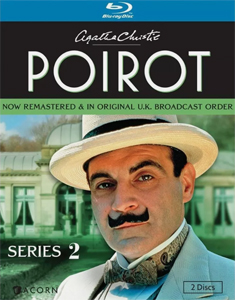Even more so than in Season 1, “Agatha Christie’s Poirot” Season 2 (1990, ITV) locks in as a cozy mystery TV series. The experience of reading Agatha Christie short stories is cozy in its own way, because we soften Poirot’s harsh edges in our minds. If he’s cruel to Hastings or snappish to Japp or all business toward Miss Lemon, that’s just “Poirot being Poirot.”
Understanding that Poirot on the page will always be the only definitive Poirot, Clive Exton and his TV writing team – along with David Suchet and the three other leads – recognize that cozy TV isn’t a collaboration with the viewer. It’s up to them to provide the warmth.
As such, Christie provides the plots for these nine episodes, but the cuddliness comes from new versions of Poirot, Hastings (Hugh Frasier), Japp (Philip Jackson) and Miss Lemon (Pauline Moran). Their characterizations start with Christie’s words, but TV was definitely not on the author’s mind when she wrote these stories.

“Agatha Christie’s Poirot” Season 2 (1990)
ITV, nine episodes
Lead writer: Clive Exton
Starring: David Suchet, Hugh Fraser, Pauline Moran
Focusing on early cases
The medium wasn’t available to the public until 1935, and seven of the short stories that became Season 2 episodes were written in 1923. “Double Sin” was published in 1928, and the lone novel adapted in Season 2, “Peril at End House,” came out in 1932, so all nine stories predate TV. (Season 1 dramatized some 1920s stories, but also some from the ’30s and ’40s.)
Generally, Season 2’s choice to adapt early works leads to engagingly straightforward puzzles, with the notable exceptions of the bizarrely convoluted “Adventure of the Cheap Flat” and the almost incomprehensible “Kidnapped Prime Minister.” But even then, we enjoy the character interplay.
Overall, these mash-ups between Christie and Exton (etc.) are effective. The writers generally are faithful to the plots, but Poirot, Hastings and Japp are undeniably friends in addition to colleagues, going to the theater and cinema together. Miss Lemon, who continues to be the most original-to-the-TV-show character, combines the secretarial duties of Christie’s elderly Lemon and the butler skills of Georges, but Moran’s expressiveness gives this Miss Lemon a richness beyond her competency.
Here are my rankings of the nine Season 2 episodes, along with a note of what U.S. short story collection the source material appears in, and a link to that collection’s review. (SPOILERS FOLLOW.)
1. “The Disappearance of Mr. Davenheim” (episode 5, written by David Renwick)
In my favorite episode of Season 2, “Poirot” manages to pull off a disguise-based plot with actor Kenneth Colley, even flat-out showing the sly Mr. Davenheim applying the disguise. Some viewers might cop to the notion of a man faking his own death, whereas others might be caught off guard. But regardless, Poirot’s playfulness seals this as a standout episode. He has made a bet with Japp that he can solve the case without leaving his flat/office, so long as Japp and Hastings provide him with all the information. Also, to pass the time, Poirot does a variety of magic tricks. This is very much Suchet’s Poirot and not Christie’s, but I’m on board for it.
Story: “Poirot Investigates”
2. “The Cornish Mystery” (4, Clive Exton)
This is a sharply adapted double-bluff mystery, wherein the villain aims to eliminate two people – one via murder, one via framing him for that murder – so he’ll then end up with an inheritance payday from which he was initially two steps removed. The episode features several strong performances, ranging to both ends of the acting spectrum. Jerome Willis plays the wrongfully accused Edward Pengelley with stately reserve, while John Bowler plays the scheming Jacob Radnor like a “Columbo” villain. Both fit tidily into the tale.
Story: “The Under Dog and Other Stories”
3. “Double Sin” (6, Exton)
This is a strong “things aren’t what they seem” episode largely because Caroline Milmoe is well cast as Mary Durrant, a young woman who is supposedly distraught from having valuable miniatures stolen from her on a bus tour. Rather than the stereotypical striking beauty who mesmerizes Hastings (which was, for a moment, the casting choice I would’ve wished), she simply seems like an innocent, sympathetic victim. The episode is also fun because Poirot uses this as a test case for Hastings to solve, since there’s no time pressure. The convolution of a schemer selling her own valuables and also claiming they were stolen – aiming for a double payout – barely holds together. We unfortunately don’t see how a court ruling would’ve played out, but it’s a fascinating moral/legal thought experiment: If someone buys stolen items in good faith, should he have to return them to the original owner?
Story: “Double Sin and Other Stories”
4. “The Veiled Lady” (2, Exton)
Stories with one layer of bluff, when combined with fun antics from Poirot and Hastings, are among the most easy-to-like “Poirot” structures. Here, Hastings is distracted by the beauty of the titular lady while Poirot stays focused on the case. In a dramatic departure from what Christie would write, Poirot goes undercover as a jumpsuited worker installing a security system, thus setting the stage for he and Hastings to probe the house for a case-clinching box. Viewers’ tolerance for the show’s departures from Christie’s characterization is heavily tested here, but if you’re up for Suchet’s game (as I am), this might be a favorite episode.
Story: “Poirot Investigates”
5. “The Lost Mine” (3, Michael Baker, Renwick)
I don’t have a high tolerance for “Poirot” breaking into action sequences, but that’s because almost all of them are generic car chases. This episode’s sequence, though, shows how Japp coordinates a vehicle pursuit of suspects using the police’s radio system, assisted by office workers who slide model cars around a huge map. It’s an instructive glimpse into the procedure of the 1930s (when these episodes are set, despite the stories being written a decade earlier). It’s always a challenge to visually adapt a story where the plot hinges on a disguise, and this one cheats somewhat by never showing what the actual person looks like. On the other hand, it’s clear the guy at the beginning is in a “Chinaman” disguise, so it plays fair enough.
Story: “Poirot Investigates”
6. “The Adventure of the Western Star” (9, Exton)
This story is kind of a big fake-out, in that there is never both an Eastern and Western Star, but just one large diamond in play – along with the requisite “paste” diamond as various shady folks attempt to get their hands on the titular gem. It’s a familiar type of fun, with Hastings being smitten by the glamorous holder of the diamond, and Poirot also being smitten by a Belgian actress (and annoyed by everyone’s surprise that his country has produced a film star). A centerpiece sequence wherein a scheming woman fakes out the investigators with a staged theft is well done, but I must admit that Christie’s ubiquitous stories of gem thefts and paste replacements blend together for me.
Story: “Poirot Investigates”
7. “Peril at End House” (1, Exton; double-length)
I watched the TV series’ first adaptation of a novel through a singular lens – clearly remembering who the villain is. For some reason, I remember the details of the short stories less, and thus surprise is often preserved. Although Polly Walker is fine as Nick Buckley, the psychologically troubled supposed victim of murder attempts, and the vacation setting provides a sense of leisure, I found the experience rather one-note (which, as I say, is partially my fault). Although it’s logical to have novel adaptations be double-length, “Peril at End House” feels unnecessarily long.
Novel: “Peril at End House”
8. “The Adventure of the Cheap Flat” (7, Russell Murray)
As with Christie’s source material, this episode features an engagingly bizarre premise but then totters off the rails of plausibility. Like Poirot, a viewer can’t help but be sucked in by the question of why a flat is rented out well below the market rate, but only to a specific, oblivious couple (one of whom is Samantha Bond, Moneypenny from the Nineties “James Bonds”). After a tale that involves (devolves into?) international spy intrigue and a Pollyana commentary on how cases can be closed without the use of guns (Poirot is anti-gun and an American FBI visitor wants to blow everyone away), the plot can only be described as absurd. But it is wild to see Poirot rent a flat above the titular one as part of his process, and it’s neat to see a 1930s style of posh waste disposal, as a back stairwell in the complex is used for putting out one’s trash cans.
Story: “Poirot Investigates”
9. “The Kidnapped Prime Minister” (8, Exton)
I admit it, there are some Christie stories where I’m unable to follow the logic. That’s the case here, and with Exton’s adaptation. I generally got the idea that the chauffeur – overlooked by everyone except Poirot – is key to the titular kidnapping, but my brain whiffed on the politics. (The “All About Agatha” podcast episode about this story nicely goes through the political undertones.) In a showy hour that includes a substantial supporting cast of British soldiers in the grand finale, my favorite part is a character beat for Poirot. One official says he won’t rest until the PM is found, but Poirot intends to get a good night’s sleep for the sake of his brainpower. He knows thinking will solve the case, not running around looking busy.
Story: “Poirot Investigates”
IMDb Top 250 trivia
- “Poirot” ranks No. 149 in the IMDb TV rankings with an 8.6 rating.
- Viewers appreciated the show’s first novel adaptation, as “Peril at End House” tops Season 2’s ratings with an 8.0. The lowest-rated episode is the finale, “The Adventure of the Western Star,” at 7.2.


